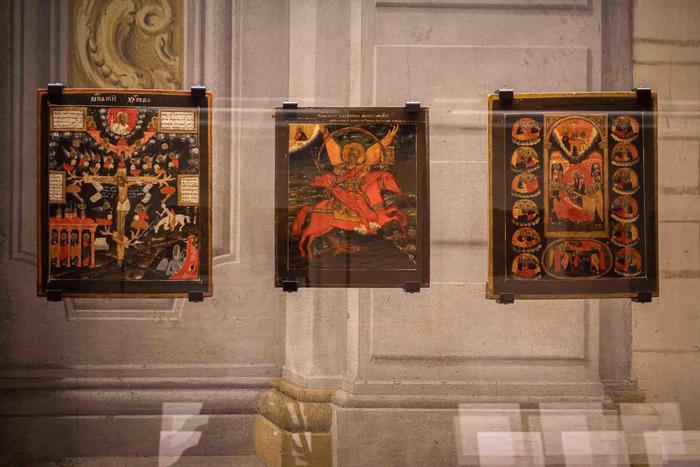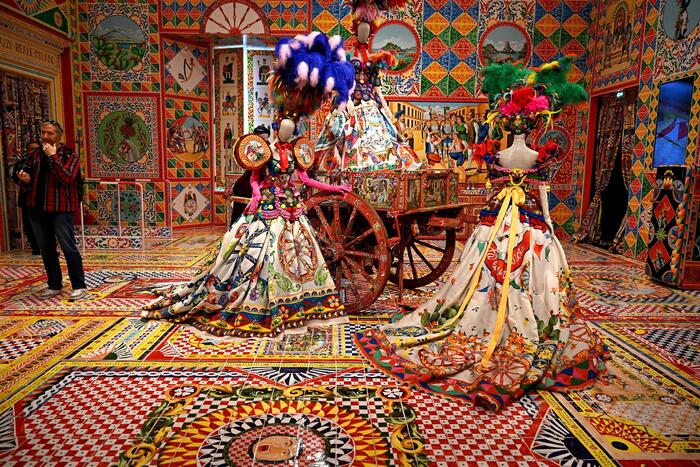FLORENCE - The Menologio, the calendar of Orthodox religious holidays divided by semesters, whose panels show sacred scenes and figures of saints, each identified by an inscription. The icon with Saint Catherine of Alexandria, datable to 1693-1694, in which the martyr princess is depicted with attributes similar to those of Western art, such as the palm and the wheel of martyrdom, the books and the armillary sphere that allude to his vast knowledge. And then the Tikhvin icon of the Mother of God, dated July 16, 1728 and signed by Vasily Gryaznov, a replica of the miraculous image that according to tradition appeared in 1383 in Tikhvin, in the Novgorod territory. Or again, the icon depicting the Mother of God, of the type called "In you every creature rejoices", and the one with the Beheading of the Baptist,both linked to Medici collecting. These are just some of the ancient jewels, all made between the late 1500s and the mid-1700s, which make up the collection of Russian sacred art on display starting from January 2 on a permanent basis in the new Museum of Russian Icons in Florence, built in the palace of the Palazzo Pitti, with an installation curated by the architect Mauro Linari.
Composed of 78 icons, mostly of medium and small size and intended for domestic and personal devotion, the collection - already collected in Florence by the Medici and especially by the Lorraine during the eighteenth century and the following century - represents the oldest of its kind to the world outside of Russia itself: thanks to the new museum it will find a special location in four large rooms decorated with seventeenth-century frescoes and overlooking the courtyard on the ground floor of Palazzo Pitti, all newly restored spaces that will become part of the normal tour itinerary and until now never open to the public on a regular basis. The new year therefore opens with a special project, of great charm and of important symbolic significance, also considering that, at the same time, also the Palatine Chapel,with the nineteenth-century frescoes by Luigi Ademollo, now fully restored, it will be reopened and can be visited every day.
"With the inauguration of the Museum of Russian Icons, which coincides with the daily and permanent accessibility of the Palatine Chapel, now returned to its splendor thanks to skilful lighting, a great step is taken towards the opening to the public of all frescoed rooms on the ground floor of Palazzo Pitti ", says the director of the Uffizi Galleries Eike Schmidt. "The proximity of the Russian icons to the Palatine Chapel becomes a metaphor for a confessional bridge between Orthodox and Catholics that recalls the common spiritual roots and the frequent cultural exchanges between Italy and Russia that took place over the centuries and still persist". In a path marked by lightness and transparency, the visitor will be able to browse through a collection that embodies thespiritual experience of the Russian people and the Orthodox Church and whose splendid exhibits (all with captions in Italian, English and Cyrillic) have crossed centuries and territories to finally reach the Florentine capital: the oldest examples belonged to the grand dukes of the Medici family and they appear mentioned around the middle of the 17th century in the inventories of the furnishings of the Chapel of the Relics of Palazzo Pitti. The largest group, on the other hand, arrived in Florence during the reign of Francesco Stefano di Lorena (1737-1765).the oldest specimens belonged to the Grand Dukes of the Medici family and appear mentioned around the mid-17th century in the inventories of the furnishings of the Chapel of the Relics of Palazzo Pitti. The largest group, on the other hand, arrived in Florence during the reign of Francesco Stefano di Lorena (1737-1765).the oldest specimens belonged to the Grand Dukes of the Medici family and appear mentioned around the mid-17th century in the inventories of the furnishings of the Chapel of the Relics of Palazzo Pitti. The largest group, on the other hand, arrived in Florence during the reign of Francesco Stefano di Lorena (1737-1765).
Accompanying the opening of the museum is also the virtual exhibition "The Light of the Sacred: Russian Icons at Palazzo Pitti", curated by Daniela Parenti, curator of medieval and fifteenth-century painting, and Russian icons of the Uffizi, available on the Gallerie website degli Uffizi (uffizi.it/mostre-virtuali), and the first video in Russian (with subtitles), with an introduction to the historic collection of the Pitti Palace by Zelfira Tregulova, director of the Tretyakovskaya Gallery in Moscow, museum with the largest and most important collection of Russian icons in the world.








